Composites of Lignin-Based Biochar with BiOCl for Photocatalytic Water Treatment: RSM Studies for Process Optimization
Abstract
1. Introduction
2. Materials and Methods
2.1. Materials
2.2. Synthesis of Biochar and BC-BiOCl Photocatalyst
2.3. Characterization of BiOCl-Biochar
2.4. Photocatalytic Degradation Studies
2.5. Experiment Design and Analysis
3. Results and Discussion
3.1. Characterization of the Pure Phases (BiOCl Nanoparticles and Lignin-Derived Activated Biochar)
3.2. Characterization of BiOCl-Biochar Composites
3.3. Control Experiment
3.4. Kinetic Studies
3.5. Statistical Analysis and Optimization Study of MO Removal
3.6. Process Optimization and Model Validation
3.7. Reusability Study
3.8. Photo-Remediation Mechanisms
4. Conclusions
Supplementary Materials
Author Contributions
Funding
Data Availability Statement
Conflicts of Interest
References
- Shi, W.; Wang, X. Inorganic environmental materials and their applications in pollutant removal. J. Inorg. Mater. 2020, 35, 257–259. [Google Scholar]
- Yao, L.; Yang, H.; Chen, Z.; Qiu, M.; Hu, B.; Wang, X. Bismuth oxychloride based materials for the removal of organic pollutants in wastewater. Chemosphere 2021, 273, 128576. [Google Scholar] [CrossRef] [PubMed]
- Liu, W.; Peng, R. Recent advances of bismuth oxychloride photocatalytic material: Property, preparation and performance enhancement. J. Electron. Sci. Technol. 2020, 2, 100020. [Google Scholar] [CrossRef]
- Zeghioud, H.; Khellaf, N.; Amrane, A.; Djelal, H.; Bouhelassa, M.; Assadi, A.; Rotimi, S. Combining photocatalytic process and biological treatment for Reactive Green 12 degradation: Optimization, mineralization, and phytotoxicity with seed germination. Environ. Sci. Pollut. Res. 2021, 28, 12490–12499. [Google Scholar] [CrossRef]
- Saeed, M.; Usman, M.; Ibrahim, M.; Haq, A.; Khan, I.; Ijaz, H.; Akram, F. Enhanced photocatalytic degradation of methyl orange using p–n Co3O4-TiO2 hetero-junction as catalyst. Int. J. Chem. Eng. 2020, 18, 20200004. [Google Scholar] [CrossRef]
- Arkas, M.; Anastopoulos, I.; Giannakoudakis, D.A.; Pashalidis, I.; Katsika, T.; Nikoli, E.; Panagiotopoulos, R.; Fotopoulou, A.; Vardavoulias, M.; Douloudi, M. Catalytic neutralization of water pollutants mediated by dendritic polymers. Nanomaterials 2022, 12, 445. [Google Scholar] [CrossRef]
- Douloudi, M.; Nikoli, E.; Katsika, T.; Arkas, M. Chapter 17—Dendritic Polymers for Water Resources Remediation. In Novel Materials for Environmental Remediation Applications; Dimitrios, A., Giannakoudakis Lucas, M., Ioannis, A., Eds.; Elsevier: Amsterdam, The Netherlands, 2023; pp. 435–490. [Google Scholar] [CrossRef]
- Nguyen, T.H.A.; Le, V.T.; Doan, V.-D.; Tran, A.V.; Nguyen, V.C.; Nguyen, A.-T.; Vasseghian, Y. Green synthesis of Nb-doped ZnO nanocomposite for photocatalytic degradation of tetracycline antibiotic under visible light. Mater. Lett. 2022, 308, 131129. [Google Scholar] [CrossRef]
- Zheng, M.; Chen, J.; Zhang, L.; Cheng, Y.; Lu, C.; Liu, Y.; Singh, A.; Trivedi, M.; Kumar, A.; Liu, J. Metal organic frameworks as efficient adsorbents for drugs from wastewater. Mater. Today Commun. 2022, 31, 103514. [Google Scholar] [CrossRef]
- Esposito, M.C.; Corsi, I.; Russo, G.L.; Punta, C.; Tosti, E.; Gallo, A. Biomolecules the era of nanomaterials: A safe solution or a risk for marine environmental pollution? Biomolecules 2021, 11, 441. [Google Scholar] [CrossRef]
- Rafiee, E.; Noori, E.; Zinatizadeh, A.; Zanganeh, H. A new visible driven nanocomposite including Ti-substituted polyoxometalate/TiO2: Synthesis, characterization, photodegradation of azo dye process optimization by RSM and specific removal rate calculations. J. Mater. Sci. Mater. Electron. 2018, 29, 20668–20679. [Google Scholar] [CrossRef]
- Doan, V.D.; Nguyen, N.V.; Nguyen, T.L.-H.; Tran, V.A.; Le, V.T. High-efficient reduction of methylene blue and 4-nitrophenol by silver nanoparticles embedded in magnetic graphene oxide. Environ. Sci. Pollut. Res. 2021, 1–11. [Google Scholar] [CrossRef] [PubMed]
- Nambela, L.; Haule, L.; Mgani, Q. A review on source, chemistry, green synthesis and application of textile colorants. J. Clean. Prod. 2020, 246, 119036. [Google Scholar] [CrossRef]
- Hussain, S.; Khan, N.; Gul, S.; Khan, S.; Khan, H. Contamination of water resources by food dyes and its removal technologies. Water Chem. 2019, 1–14. [Google Scholar] [CrossRef]
- Dong, X.; Li, Y.; Li, D.; Liao, D.; Qin, T.; Prakash, O.; Kumar, A.; Liu, J. A new 3D 8-connected Cd(II) MOF as a potentphotocatalyst for oxytetracycline antibiotic degradation. CrystEngComm 2022, 24, 6933. [Google Scholar] [CrossRef]
- Yadav, A.A.; Hunge, Y.M.; Kang, S.-W.; Fujishima, A.; Terashima, C. Enhanced photocatalytic degradation activity using the V2O5/RGO composite. Nanomaterials 2023, 13, 338. [Google Scholar] [CrossRef]
- Hunge, Y.M.; Yadav, A.A.; Kang, S.-W.; Mohite, B.M. Role of nanotechnology in photocatalysis application. Recent Pat. Nanotechnol. 2023, 17, 5–7. [Google Scholar] [CrossRef]
- Weng, B.; Lu, K.-Q.; Tang, Z.; Ming, H.; Chen, H.M.; Xu, Y.J. Stabilizing ultrasmall Au clusters for enhanced photoredox catalysis. Nat. Commun. 2018, 9, 1–11. [Google Scholar] [CrossRef]
- Gao, Q.; Weng, B.; Jin, P.; Yuan, S.; Gui, X.; Zheng, J.; Xu, D.; Wang, Y.; Volodine, A.; Sun, L.; et al. Rapid solute transfer photocatalytic membrane: The combination of host–guest interaction and photocatalyst load. Chem. Eng. J. 2022, 446, 137316. [Google Scholar] [CrossRef]
- Hunge, Y.M.; Yadav, A.A.; Kang, S.-W.; Kim, H. Facile synthesis of multitasking composite of silver nanoparticle with zinc oxide for 4-nitrophenol reduction, photocatalytic hydrogen production, and 4-chlorophenol degradation. J. Alloys Compd. 2022, 928, 167133. [Google Scholar] [CrossRef]
- Hunge, Y.M.; Yadav, A.A.; Kang, S.-W. Photocatalytic degradation of eriochrome Black-T Using BaWO4/MoS2 composite. Catalysts 2022, 12, 1290. [Google Scholar] [CrossRef]
- Mian, M.; Liu, G. Recent progress in biochar-supported photocatalysts: Synthesis, role of biochar, and applications. RSC Adv. 2018, 8, 14237–14248. [Google Scholar] [CrossRef] [PubMed]
- Yang, Q.; Cheng, H.; Wang, W.; Huang, B.; Zhang, X.; Dai, Y. Three-dimensional BiOX (X = Cl Br and I) hierarchical architectures: Facile ionic liquid-assisted solvothermal synthesis and photocatalysis towards organic dye degradation. Mater. Lett. 2013, 100, 285–288. [Google Scholar] [CrossRef]
- Wu, Z.; Luo, W.; Zhang, H.; Jia, Y. Strong pyro-catalysis of shape-controllable bismuth oxychloride nanomaterial for wastewater remediation. Appl. Surf. Sci. 2020, 513, 145630. [Google Scholar] [CrossRef]
- Shfeizadeh, S.; Bayati, B.; SilvaMartínez, S.; Mansouri, M.; AghaeinejadMeybodi, A. Experimental and modeling study of dye removal by photocatalysis with chitin stabilized TiO2/ZnO nanocomposite. Int. J. Environ. Sci. Tech. 2022, 19, 7321–7336. [Google Scholar] [CrossRef]
- Zhang, H.; Chiew, J.; Jaenicke, S.; Gondal, M.; Dastageer, A.; Basheer, C.; Khuan, C. BiOBrnI1−n solid solutions as versatile photooxidation catalysts for phenolics and endocrine disrupting chemicals. Catal. Today 2021, 375, 547–557. [Google Scholar] [CrossRef]
- Huang, H.; Xiao, K.; He, Y.; Zhang, T.; Dong, F.; Du, X.; Zhang, Y. In situ assembly of BiOI@Bi12O17Cl2 p-n junction: Charge induced unique front-lateral surfaces coupling heterostructure with high exposure of BiOI {001} active facets for robust and nonselective photocatalysis. Appl. Catal. B Environ. 2016, 199, 75–86. [Google Scholar] [CrossRef]
- Zhao, Q.; Xing, Y.; Liu, Z.; Ouyang, J.; Du, C. Synthesis and Characterization of Modified BiOCl and Their Application in Adsorption of Low-Concentration Dyes from Aqueous Solution. Nanoscale Res. Lett. 2018, 13, 1–13. [Google Scholar] [CrossRef]
- Li, S.; Wang, Z.; Zhao, X.; Yang, X.; Liang, G.; Xie, X. Insight into enhanced carbamazepine photodegradation over biochar-based magnetic photocatalyst Fe3O4/BiOBr/BC under visible LED light irradiation. Chem. Eng. J. 2019, 360, 600–611. [Google Scholar] [CrossRef]
- Duo, F.; Wang, Y.; Mao, X.; Zhang, X.; Wang, Y.; Fan, C. A BiPO4/BiOCl heterojunction photocatalyst with enhanced electron-hole separation and excellent photocatalytic performance. Appl. Surf. Sci. 2015, 340, 35–42. [Google Scholar] [CrossRef]
- Xu, M.; Yanga, J.; Suna, C.; Liua, L.; Cuia, Y.; Lianga, B. Performance enhancement strategies of bi-based photocatalysts: A review on recent progress. Chem. Eng. J. 2020, 289, 124402. [Google Scholar] [CrossRef]
- Wang, L.; Wang, L.; Du, Y.; Xu, X.; Dou, S.X. Progress and perspectives of bismuth oxyhalides in catalytic applications. Mater. Today Phys. 2021, 16, 100294. [Google Scholar] [CrossRef]
- Hou, J.; Dou, Q.; Jiang, T.; Yin, J.; Liu, J.; Li, Y.; Zhang, G.; Wang, X. BiOCl/cattail carbon composites with hierarchical structure for enhanced photocatalytic activity. Sol. Energy 2020, 211, 1263–1269. [Google Scholar] [CrossRef]
- Luo, Y.; Wang, Y.; Zhu, Y.; Xue, M.; Zheng, A.; Han, Y.; Yin, Z.; Hong, Z.; Xie, C.; Li, X.; et al. Ball milled bismuth oxychloride/biochar nanocomposites with rich oxygen vacancies for reactive red 120 adsorption in aqueous solution. Biochar 2022, 4, 1–12. [Google Scholar] [CrossRef]
- Guo, Y.; Huang, H.; He, Y.; Tian, N.; Zhang, T.; Chu, P.; An, Q.; Zhang, Y. In situ crystallization for fabrication of a core–satellite structured BiOBr–CdS heterostructure with excellent visible-light responsive photoreactivity. Nanoscale 2015, 7, 11702–11711. [Google Scholar] [CrossRef] [PubMed]
- Ma, Y.; Chen, Z.; Qu, D.; Shi, J. Synthesis of chemically bonded BiOCl@Bi2WO6 microspheres with exposed (020) Bi2WO6 facets and their enhanced photocatalytic activities under visible light irradiation. Appl. Surf. Sci. 2016, 361, 63–71. [Google Scholar] [CrossRef]
- Pi, L.; Jiang, R.; Zhou, W.; Zhu, H.; Xiao, W.; Wang, D.; Mao, X. g-C3N4 modified biochar as an adsorptive and photocatalytic material for decontamination of aqueous organic pollutants. Appl. Surf. Sci. 2015, 358, 231–239. [Google Scholar] [CrossRef]
- Tavakoli, F.; Badiei, A.; Yazdian, F.; Ziarani, G.; Ghasemi, J. Optimization of Influential Factors on the Photocatalytic Performance of TiO2–Graphene Composite in Degradation of an Organic Dye by RSM Methodology. J. Clust. Sci. 2017, 28, 2979–2995. [Google Scholar] [CrossRef]
- Parit, M.; Jiang, Z. Towards lignin derived thermoplastic polymers. Int. J. Biol. Macromol. 2020, 165, 3180–3197. [Google Scholar] [CrossRef]
- Silvestri, S.; Gonçalves, M.; Veiga, P.; Matos, T.; Peralta-Zamora, P.; Mangrich, A. TiO2 supported on Salvinia molesta biochar for heterogeneous photocatalytic degradation of Acid Orange 7 dye. J. Environ. Chem. Eng. 2019, 7, 102879. [Google Scholar] [CrossRef]
- Niu, L.; Hu, Y.; Hu, H.; Zhang, X.; Wu, Y.; Giwa, A.S.; Huang, S. Kitchen-waste-derived biochar modified nanocomposites with improved photocatalytic performances for degrading organic contaminants. Environ. Res. 2022, 214, 114068. [Google Scholar] [CrossRef]
- Lee, J.; Kim, K.; Kwon, E.E. Biochar as a Catalyst. Renew. Sust. Energ. Rev. 2017, 77, 70–79. [Google Scholar] [CrossRef]
- Vinayagam, M.; Ramachandran, S.; Ramya, V.; Sivasamy, A. Photocatalytic degradation of orange G dye using ZnO/biomass activated carbon nanocomposite. J. Environ. Chem. Eng. 2018, 6, 3726–3734. [Google Scholar] [CrossRef]
- Kaya, N.; Uzun, Z.Y. Investigation of the effectiveness of pine cone biochar activated with KOH for methyl orange adsorption and CO2 capture. Biomass Convers. Biorefin. 2021, 11, 1067–1083. [Google Scholar] [CrossRef]
- Salehi, K.; Bahmani, A.; Shahmoradi, B.; Pordel, M.A.; Kohzadi, S.; Gong, Y.; Guo, H.; Shivaraju, H.P.; Rezaee, R.; Pawar, R.R.; et al. Response surface methodology (RSM) optimization approach for degradation of Direct Blue 71 dye using CuO–ZnO nanocomposite. Int. J. Environ. Sci. Technol. 2017, 14, 2067–2076. [Google Scholar] [CrossRef]
- Shojaei, S.; Nouri, A.; Baharinikoo, L.; Farahani, M.D.; Shojaei, S. Removal of the hazardous dyes through adsorption over nano zeolite-X: Simultaneous model, design and analysis of experiments. Polyhedron 2021, 196, 114995. [Google Scholar] [CrossRef]
- Hussain, S.; Khan, H.; Khan, N.; Gul, S.; Wahab, F.; Khan, K.I.; Zeb, S.; Khan, S.; Baddouh, A.; Mehdi, S.; et al. Process modeling toward higher degradation and minimum energy consumption of an electrochemical decontamination of food dye wastewater. Environ. Technol. Innov. 2021, 22, 101509. [Google Scholar] [CrossRef]
- Wu, Y.; Cao, J.P.; Hao, Z.Q.; Zhao, X.Y.; Zhuang, Q.Q.; Zhu, J.S.; Wang, X.Y.; Wei, X.Y. One-step preparation of alkaline lignin-based activated carbons with different activating agents for electric double layer capacitor. Int. J. Electrochem. Sci. 2017, 12, 7227–7239. [Google Scholar] [CrossRef]
- Li, M.; Huang, H.; Yua, S.; Tiana, N.; Dong, F.; Du, X.; Zhang, Y. Simultaneously promoting charge separation and photoabsorption of BiOX (X= Cl, Br) for efficient visible-light photocatalysis and photosensitization by compositing low-cost biochar. Appl. Surf. Sci. 2016, 386, 285–295. [Google Scholar] [CrossRef]
- Salehi, K.; Daraei, H.; Teymouri, P.; Maleki, A. Hydrothermal synthesis of surface-modified copper oxide-doped zinc oxide nanoparticles for degradation of acid black 1: Modeling and optimization by response surface methodology. J. Adv. Environ. Health Res. 2014, 2, 101–109. [Google Scholar] [CrossRef]
- Giannakoudakis, D.A.; Farahmand, N.; Łomot, D.; Sobczak, K.; Bandosz, T.J.; Colmenares, J.C. Ultrasound-activated TiO2/GO-based bifunctional photoreactive adsorbents for detoxification of chemical warfare agent surrogate vapors. Chem. Eng. J. 2020, 395, 125099. [Google Scholar] [CrossRef]
- Thommes, M.; Kaneko, K.; Neimark, A.V.; Olivier, J.P.; Rodriguez-Reinoso, F.; Rouquerol, J.; Kenneth, S.W.S. Physisorption of gases, with special reference to the evaluation of surface area and pore size distribution (IUPAC Technical Report). Pure Appl. Chem. 2015, 87, 1051–1069. [Google Scholar] [CrossRef]
- Maučec, D.; Šuligoj, A.; Ristić, A.; Dražić, G.; Pintar, A.; Tušar, N.N. Titania versus zinc oxide nanoparticles on mesoporous silica supports as photocatalysts for removal of dyes from wastewater at neutral pH. Catal. Today 2018, 310, 32–41. [Google Scholar] [CrossRef]
- Fazal, T.; Razzaq, A.; Javed, F.; Hafeez, A.; Rashid, N.; Amjad, U.; Rehman, M.; Faisal, A.; Rehman, F. Integrating adsorption and photocatalysis: A cost-effective strategy for textile wastewater treatment using hybrid biochar-TiO2 composite. J. Hazard. Mater. 2020, 390, 121623. [Google Scholar] [CrossRef]
- Giannakoudakis, D.A.; Hu, Y.; Florent, M.; Bandosz, T.J. Smart textiles of MOF/g-C3N4 nanospheres for chemical warfare agent rapid detection/detoxification. Nanoscale Horiz. 2017, 2, 356–364. [Google Scholar] [CrossRef] [PubMed]
- Barczak, M.; Dobrowolski, R.; Borowski, P.; Giannakoudakis, D.A. Pyridine-, thiol- and amine-functionalized mesoporous silicas for adsorptive removal of pharmaceuticals. Microporous Mesoporous Mater. 2020, 299, 110132. [Google Scholar] [CrossRef]
- Salonikidou, E.D.; Giannakoudakis, D.A.; Deliyanni, E.A.; Triantafyllidis, K.S. Deep desulfurization of model fuels by metal-free activated carbons: The impact of surface oxidation and antagonistic effects by mono- and poly-aromatics. J. Mol. Liq. 2022, 351, 118661. [Google Scholar] [CrossRef]
- Luo, Y.; Street, J.; Steele, P.; Entsminger, E.; Guda, V. Activated carbon derived from pyrolyzed pinewood char using elevated temperature, KOH, H3PO4, and H2O2. BioRes 2016, 11, 10433–10447. [Google Scholar] [CrossRef]
- Mian, M.M.; Liu, G.; Yousaf, B.; Fu, B.; Ahmed, R.; Abbas, Q.; Munir, M.A.M.; Ruijia, L. One-step synthesis of N-doped metal/biochar composite using NH3-ambiance pyrolysis for efficient degradation and mineralization of methylene blue. J. Environ. Sci. 2019, 78, 29–41. [Google Scholar] [CrossRef] [PubMed]
- Pang, Y.L.; Law, Z.X.; Lim, S.; Chan, Y.Y.; Shuit, S.H.; Chong, W.C.; Lai, C.W. Enhanced photocatalytic degradation of methyl orange by coconut shell–derived biochar composites under visible LED light irradiation. Environ. Sci. Pollut. Res. 2021, 28, 27457–27473. [Google Scholar] [CrossRef]
- Giannakoudakis, D.A.; Barczak, M.; Pearsall, F.; O’Brien, S.; Bandosz, T.J. Composite hydrophobic porous carbon textile with deposited barium titanate nanospheres as wearable protection medium against toxic vapors. Chem. Eng. J. 2020, 384, 123280. [Google Scholar] [CrossRef]
- Giannakoudakis, D.A.; Vikrant, K.; LaGrow, A.P.; Lisovytskiy, D.; Kim, K.-H.; Bandosz, T.J.; Colmenares, J.C. Scrolled titanate nanosheet composites with reduced graphite oxide for photocatalytic and adsorptive detoxification of toxic vapors. Chem. Eng. J. 2021, 415, 128907. [Google Scholar] [CrossRef]
- Geng, A.; Xu, L.; Gan, L.; Mei, C.; Wang, L.; Fang, X.; Li, M.; Pan, M.; Han, S.; Cui, J. Using wood flour waste to produce biochar as the support to enhance the visible-light photocatalytic performance of BiOBr for organic and inorganic contaminants removal. Chemosphere 2020, 250, 126291. [Google Scholar] [CrossRef] [PubMed]
- Gholami, P.; Dinpazhoh, L.; Khataee, A.; Orooji, Y. Sonocatalytic activity of biochar-supported ZnO nanorods in degradation of gemifloxacin: Synergy study, effect of parameters and phytotoxicity evaluation. Ultrason. Sonochem. 2019, 55, 44–56. [Google Scholar] [CrossRef]
- Giannakoudakis, D.A.; Zormpa, F.F.; Margellou, A.G.; Qayyum, A.; Colmenares-Quintero, R.F.; Len, C.; Colmenares, J.C.; Triantafyllidis, K.S. Carbon-based nanocatalysts (CnCs) for catalytic biomass valorization and hazardous organics remediation. Nanomaterials 2022, 12, 1679. [Google Scholar] [CrossRef] [PubMed]
- Abdulhameed, A.; Jawad, A.; Mohammad, T. Statistical optimization for dye removal from aqueous solution by crosslinked chitosan composite. Sci. Lett. 2020, 14, 1–14. [Google Scholar] [CrossRef]
- Yu, A.; Liu, Y.; Li, X.; Yang, Y.; Zhou, Z.; Liu, H. Modeling and optimizing of NH4+ removal from stormwater by coal-based granular activated carbon using RSM and ANN coupled with GA. Water 2021, 13, 608. [Google Scholar] [CrossRef]
- Harraz, F.A.; Mohamed, R.M.; Rashad, M.M.; Wang, Y.C.; Sigmund, W. Magnetic nanocomposite based on titania–silica/cobalt ferrite for photocatalytic degradation of methylene blue dye. Ceram. Int. 2014, 40, 375–384. [Google Scholar] [CrossRef]
- Senthilraja, A.; Subash, B.; Krishnakumar, B.; Rajamanickam, D.; Swaminathan, M.; Shanthi, M. Synthesis, characterization and catalytic activity of co-doped Ag–Au–ZnO for MB dye degradation under UV-A light. Mater. Sci. Semicond. Process. 2014, 22, 83–91. [Google Scholar] [CrossRef]
- Wei, X.; Akbar, M.U.; Raza, A.; Li, G. A review on bismuth oxyhalide based materials for photocatalysis. Nanoscale Adv. 2021, 3, 3353–3372. [Google Scholar] [CrossRef] [PubMed]
- Lv, X.; Lam, F.L.Y.; Hu, X. A Review on Bismuth Oxyhalide (BiOX, X=Cl, Br, I) Based Photocatalysts for Wastewater Remediation. Front. Catal. 2022, 2, 839072. [Google Scholar] [CrossRef]
- Giannakoudakis, D.A.; Qayyum, A.; Barczak, M.; Colmenares-Quintero, R.F.; Borowski, P.; Triantafyllidis, K.; Colmenares, J.C. Mechanistic and kinetic studies of benzyl alcohol photocatalytic oxidation by nanostructured titanium (hydro)oxides: Do we know the entire story? Appl. Catal. B Environ. 2023, 320, 121939. [Google Scholar] [CrossRef]
- Giannakoudakis, D.A.; Łomot, D.; Colmenares, J.C. When sonochemistry meets heterogeneous photocatalysis: Designing a sonophotoreactor towards sustainable selective oxidation. Green Chem. 2020, 22, 4896. [Google Scholar] [CrossRef]
- Huang, Y.; Li, H.; Balogun, M.-S.; Liu, W.; Tong, Y.; Lu, X.; Ji, H. Oxygen Vacancy Induced Bismuth Oxyiodide with Remarkably Increased Visible-Light Absorption and Superior Photocatalytic Performance. ACS Appl. Mater. Interfaces 2014, 6, 22920–22927. [Google Scholar] [CrossRef] [PubMed]
- Manikandan, S.K.; Giannakoudakis, D.A.; Prekodravac, J.R.; Nair, V.; Colmenares, J.C. Role of catalyst supports in biocatalysis. J. Chem. Technol. Biotechnol. 2023, 98, 7–21. [Google Scholar] [CrossRef]
- Giannakoudakis, D.A.; Bandsoz, T.J. 1-Graphite Oxide Nanocomposites for Air Stream Desulfurization. In Composite Nanoadsorbents; Kyzas, G.Z., Mitropoulos, A.C., Eds.; Elsevier: Amsterdam, The Netherlands, 2019; pp. 1–24. [Google Scholar] [CrossRef]

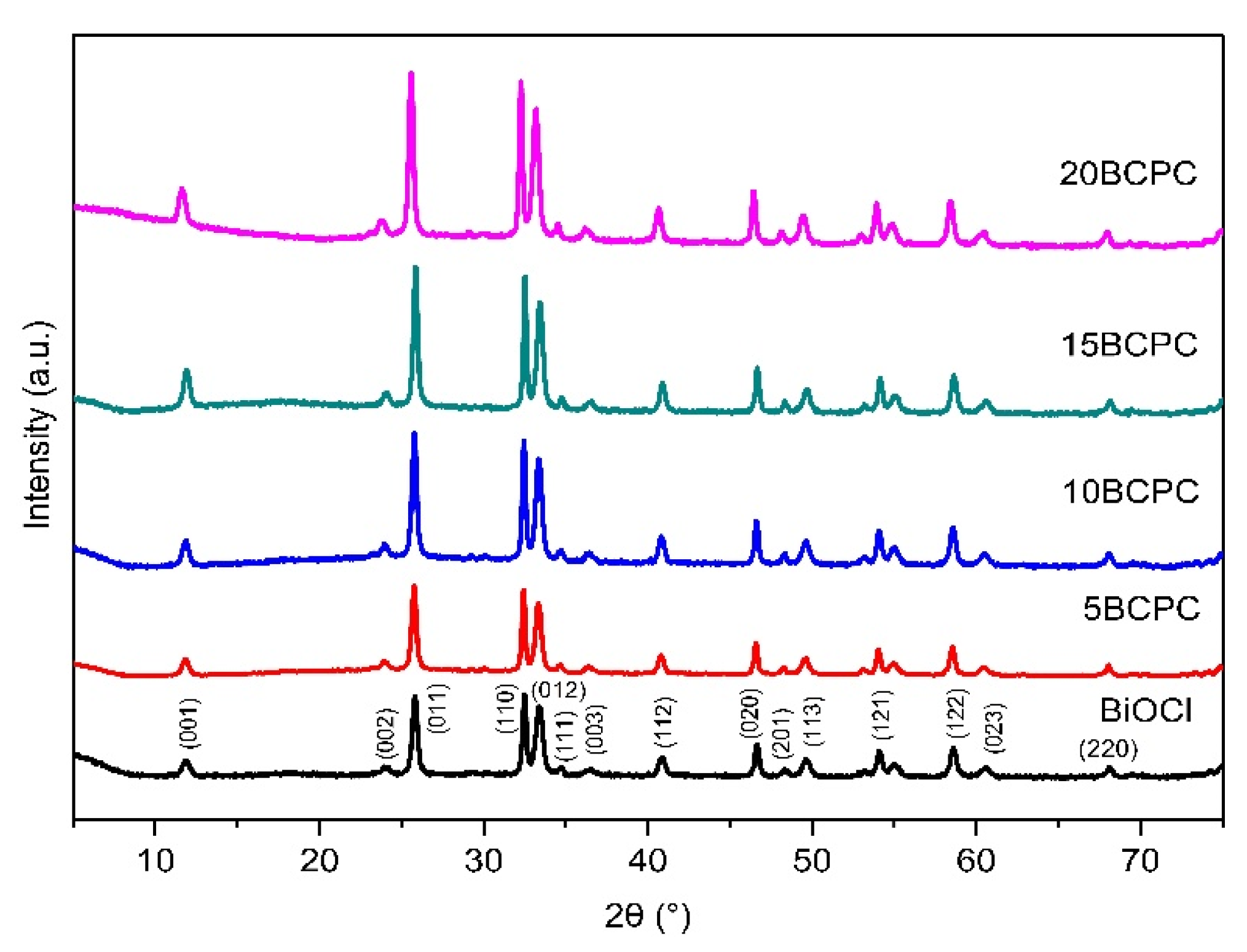
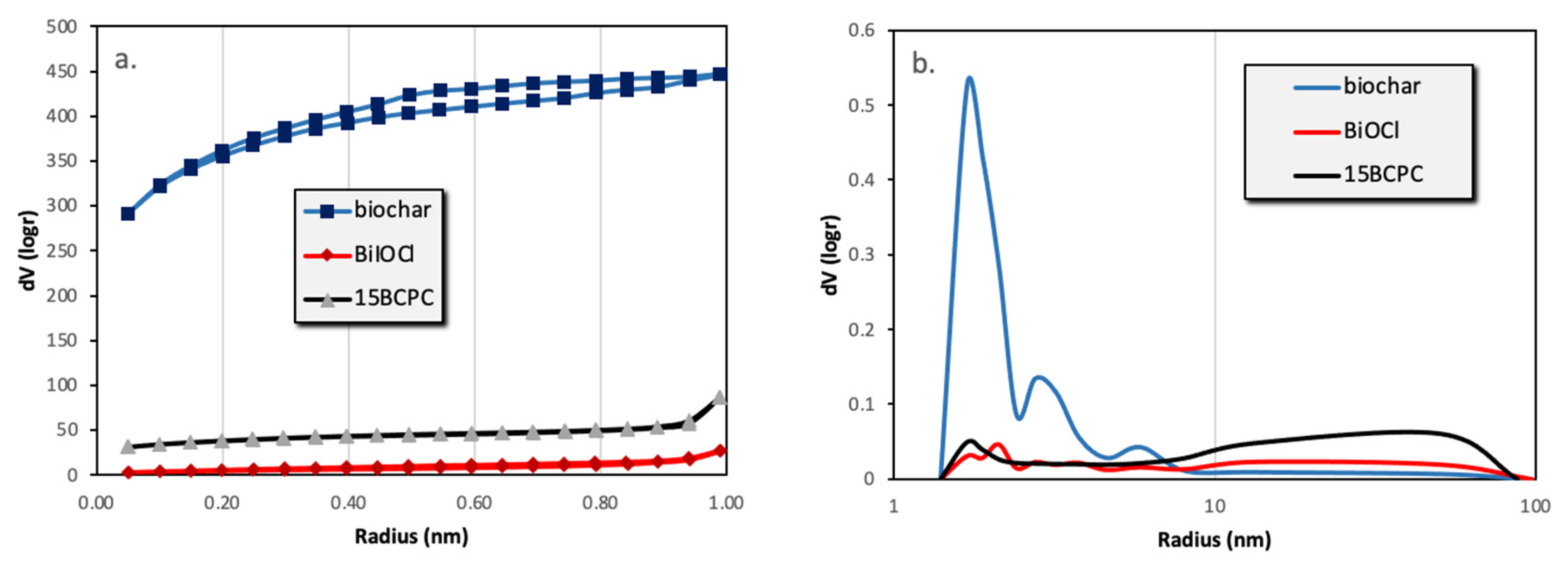


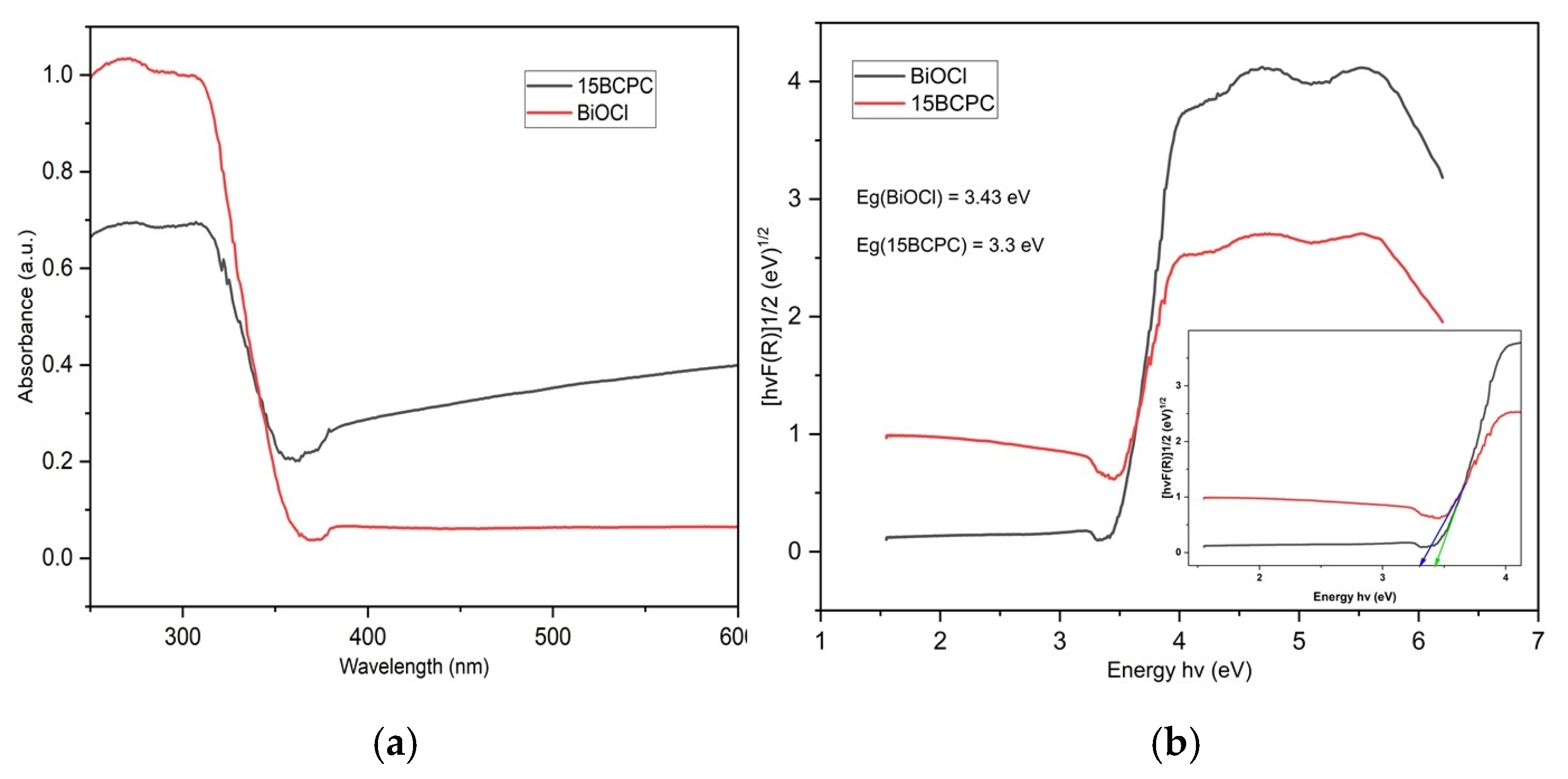
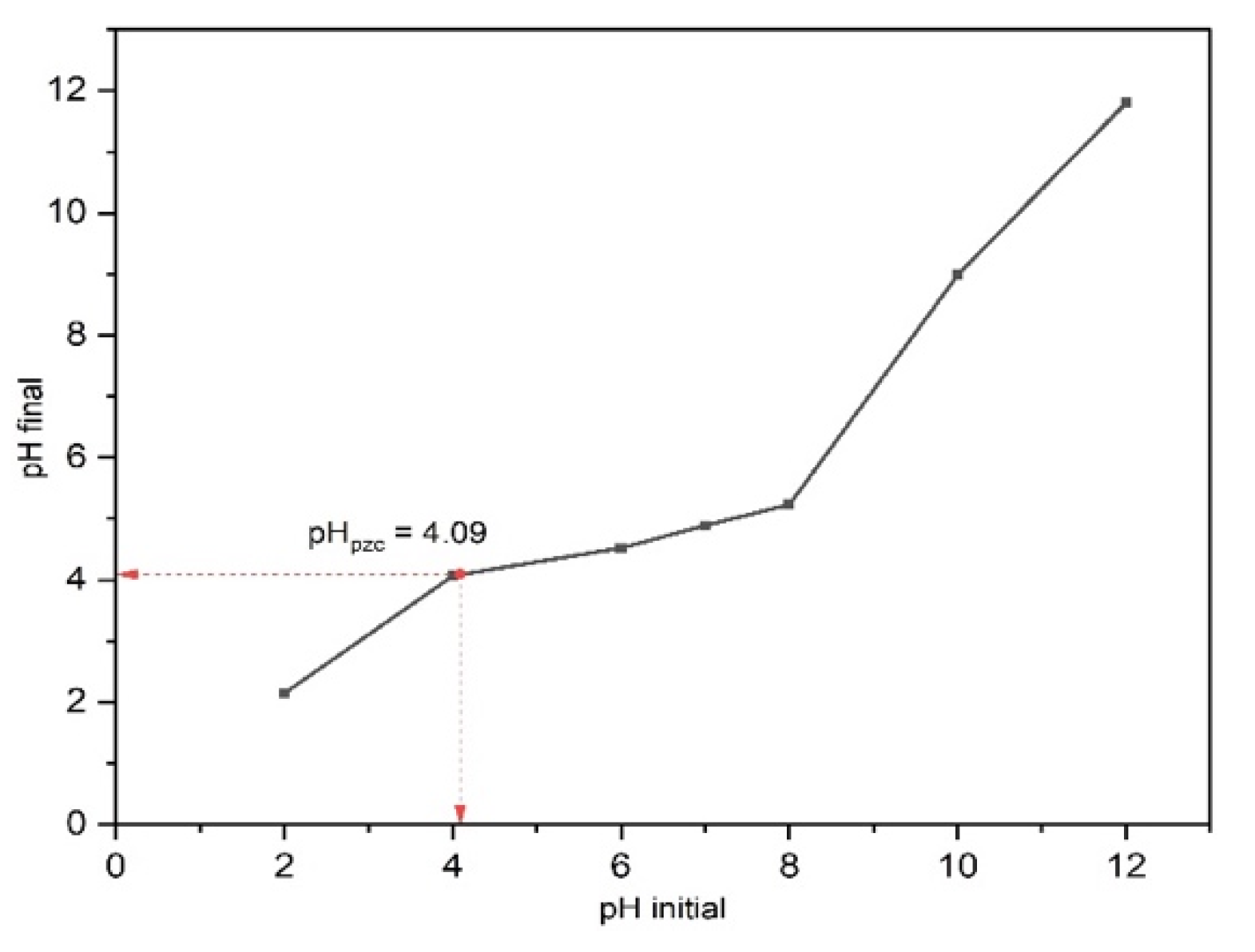
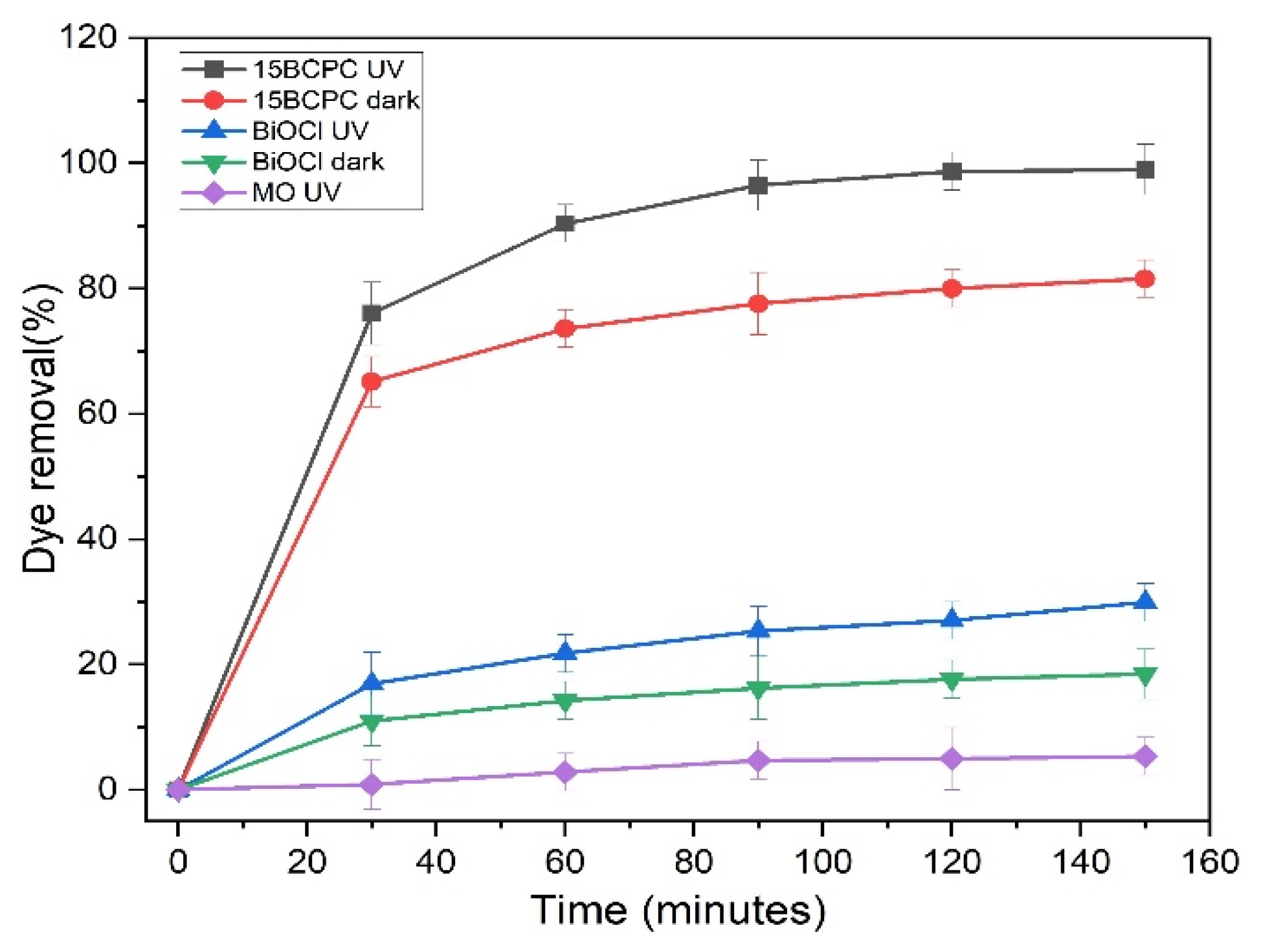
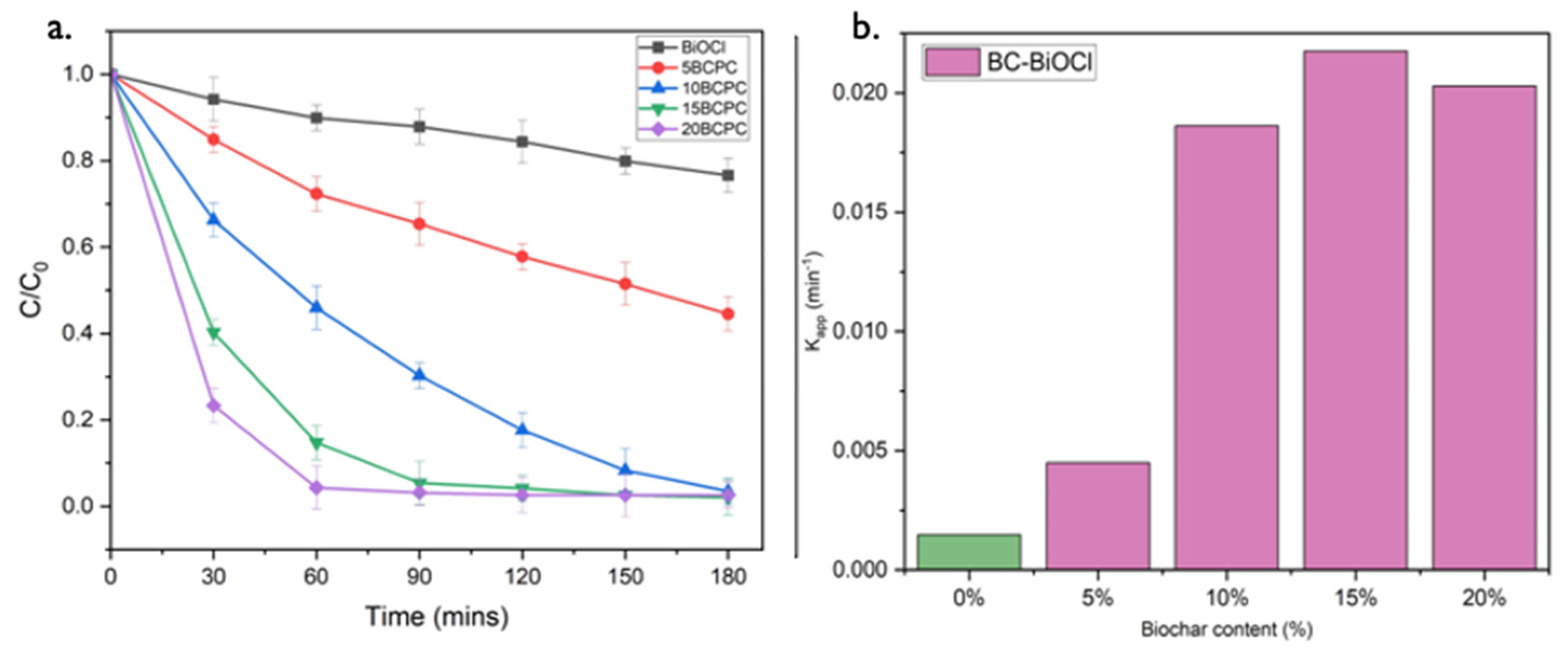

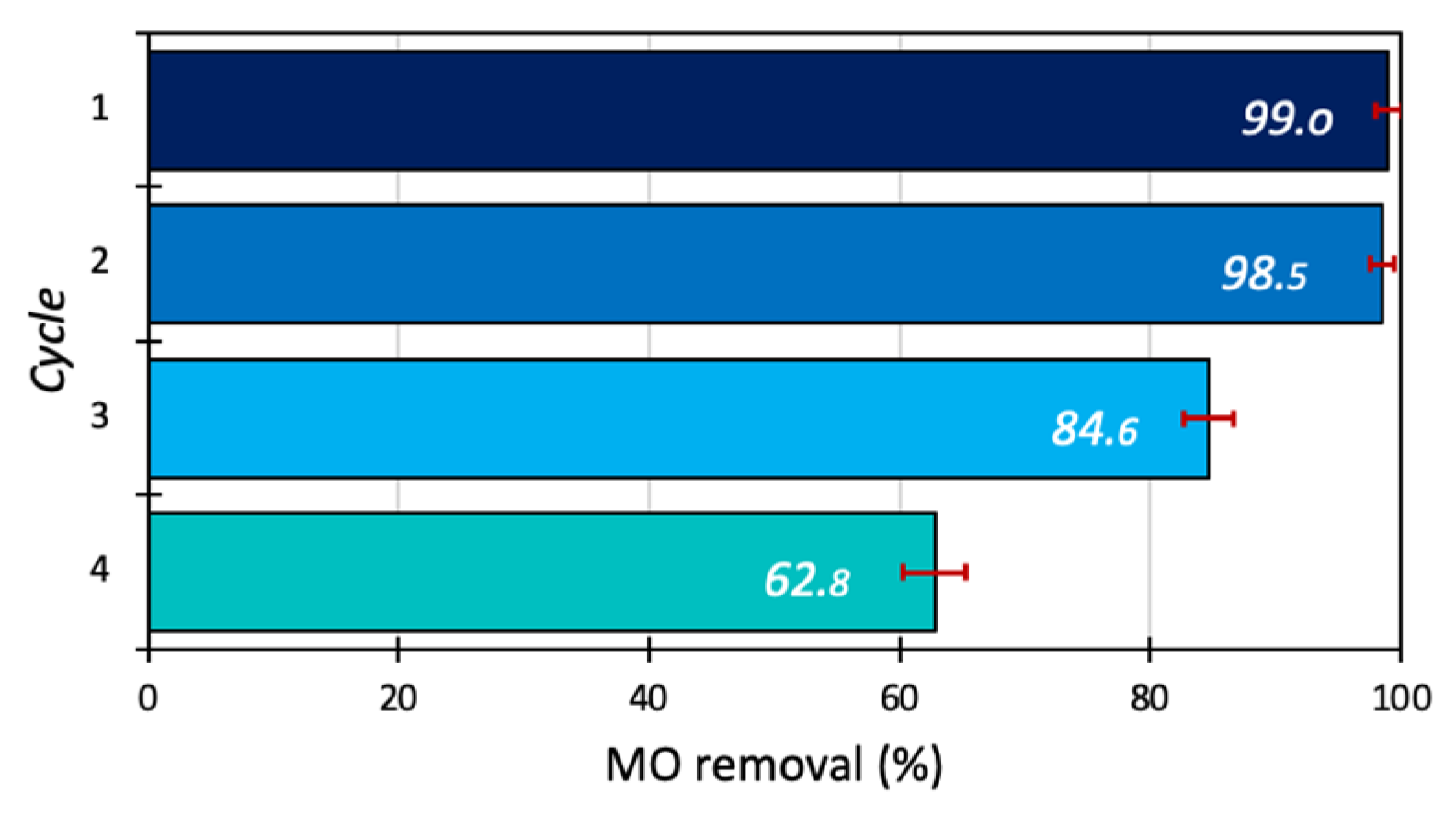
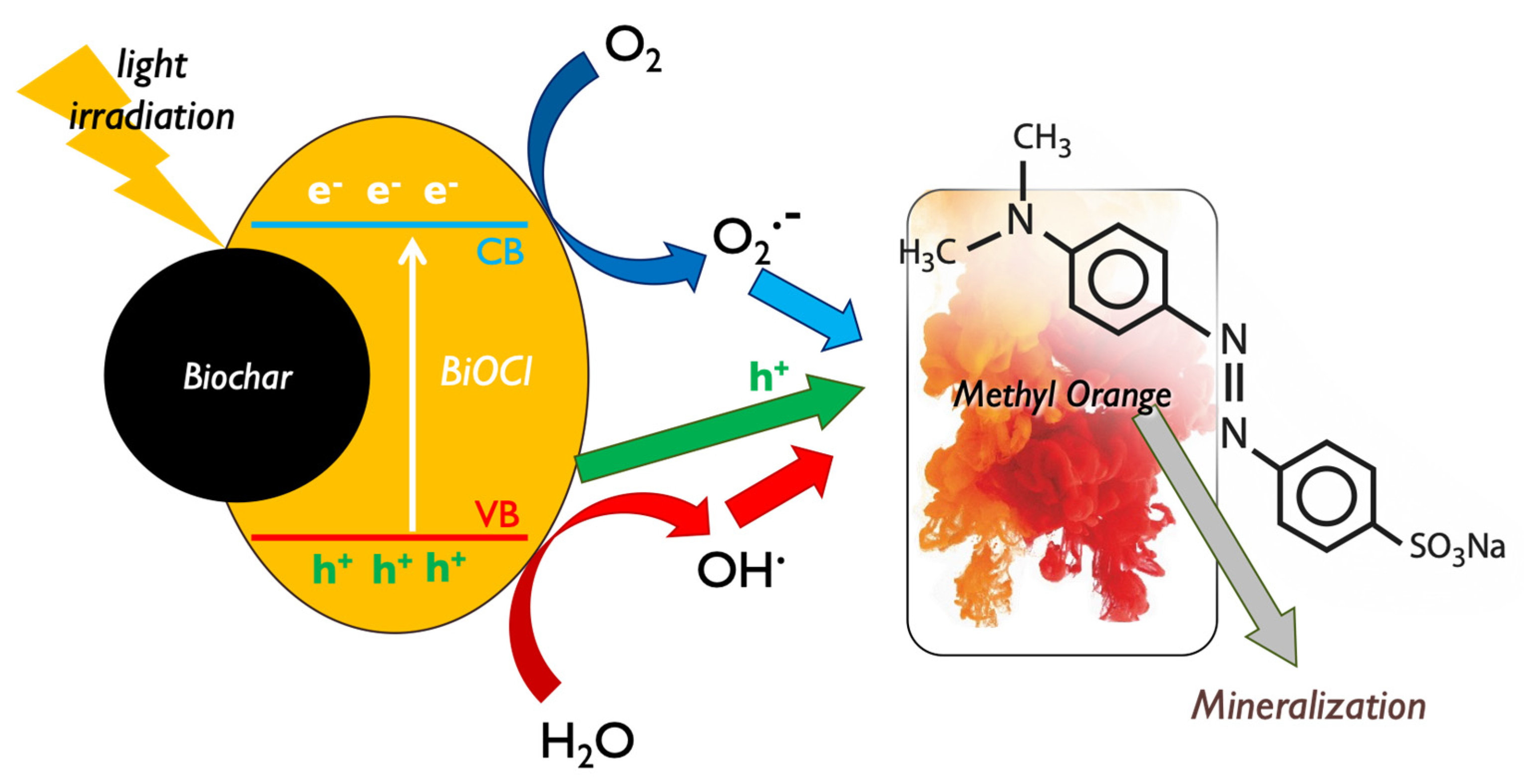
Disclaimer/Publisher’s Note: The statements, opinions and data contained in all publications are solely those of the individual author(s) and contributor(s) and not of MDPI and/or the editor(s). MDPI and/or the editor(s) disclaim responsibility for any injury to people or property resulting from any ideas, methods, instructions or products referred to in the content. |
© 2023 by the authors. Licensee MDPI, Basel, Switzerland. This article is an open access article distributed under the terms and conditions of the Creative Commons Attribution (CC BY) license (https://creativecommons.org/licenses/by/4.0/).
Share and Cite
Singh, A.K.; Giannakoudakis, D.A.; Arkas, M.; Triantafyllidis, K.S.; Nair, V. Composites of Lignin-Based Biochar with BiOCl for Photocatalytic Water Treatment: RSM Studies for Process Optimization. Nanomaterials 2023, 13, 735. https://doi.org/10.3390/nano13040735
Singh AK, Giannakoudakis DA, Arkas M, Triantafyllidis KS, Nair V. Composites of Lignin-Based Biochar with BiOCl for Photocatalytic Water Treatment: RSM Studies for Process Optimization. Nanomaterials. 2023; 13(4):735. https://doi.org/10.3390/nano13040735
Chicago/Turabian StyleSingh, Amit Kumar, Dimitrios A. Giannakoudakis, Michael Arkas, Konstantinos S. Triantafyllidis, and Vaishakh Nair. 2023. "Composites of Lignin-Based Biochar with BiOCl for Photocatalytic Water Treatment: RSM Studies for Process Optimization" Nanomaterials 13, no. 4: 735. https://doi.org/10.3390/nano13040735
APA StyleSingh, A. K., Giannakoudakis, D. A., Arkas, M., Triantafyllidis, K. S., & Nair, V. (2023). Composites of Lignin-Based Biochar with BiOCl for Photocatalytic Water Treatment: RSM Studies for Process Optimization. Nanomaterials, 13(4), 735. https://doi.org/10.3390/nano13040735










